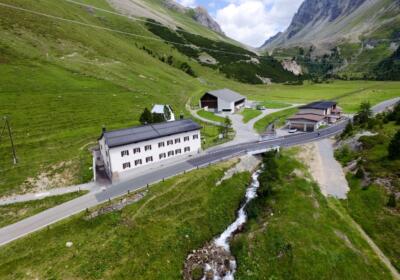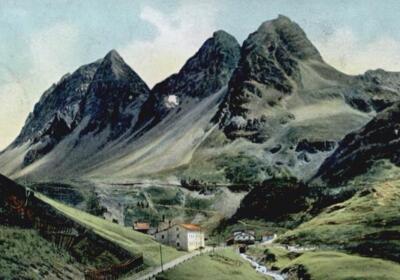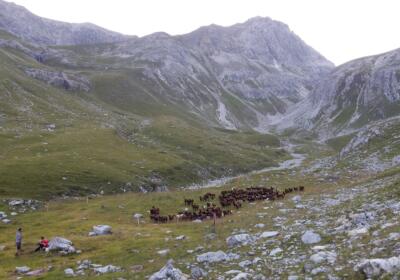For research
Since 1967 the ETH Zurich has owned the Alp Weissenstein site, located below the Albula Pass in the Kanton of Grisons at an altitude of 1900 to 2600 metres above sea level. The research station has a surface area of 234 hectares and an additional 200 hectares of leased land, offering summer pastures for roughly 150 large livestock units (dairy cows, suckler cows, young cattle, sheep and horses) for 75 to 80 days. The operational buildings, which are locted at 2000 metres above sea level, include living quarters for employees and researchers, and barns with feed storage in the case of an onset of winter and snow. They also offer the opportunity to carry out balance experiments with beef cattle indoors, and laborartory facilities for sample preparation. Mobile facilities such as a mobile milking parlour and cattle scales make it possible for experiments to be carried out on the pasture. In 2015 the residential building was completely renovated and Alp Weissenstein was integrated into the IT network of the ETH Zurich. The cow barn's interior was rebuilt and flexible housing systems for research purposes. An exercise yard was added to the barn.
Research is focused on alternative use of alp pastures by sustainable livestock systems and on the physiological and ecological effects of alpine farming. Research projects involve dairy cows, suckler cows, breeding cattle and sheep. The location of the research station also offers excellent opportunities to study high alpine vegetation which grows on different soils (bedrock). Gas emissions from the grassland are recorded throughout the year.
The facilities at Alp Weissenstein allow for research to be carried out on cattle of all ages and both sexes during the summer months. Most important are the effects of the altitude (2000 metre above sea level) on the performance of the animals, the quality of milk and meat, feed consumption, and the health and metabolism of the cattle. The animals can graze on specific allotments or be tethered and milked in a barn offering space for 12 cows. For research into suckler cows and their calves, a deep litter area can be created in the barn.
Flight by drone
Taken using a drone on 6. August 2017 by Thomas Widmer, post production by Malgorzata Sitnik and Joël Bérard.
Milestones
- 800 AD: Mention of the Albula as an important crossing
- 1654: Opening of the first hostel on Alp Weissenstein
- 1695: Bergünersteig is built, first part of the Albula Pass
- 1860: Construction of the brickworks, today's alpine dairy (AWA)
- 1860, Construction of the horse stables, today's summer barn (AWC)
- 1866: Opening of the Albula Pass
- 1871: Opening of the Albula hospice
- 1874: Opening of the current alp building (AWD)
- 1903: Opening of the Albula tunnel
- 1934: Acquisition of Alp Weissenstein by the Caflisch family
- 1944: Land improvement of the plain and drainage of the lake
- 1967: Acquisition of Alp Weissenstein by the Swiss Confederation for the ETH Zurich to use as research alp
- 1970: Creation of the new alp barn (AWS)
- 2006: Implementation of measuring station for grassland sciences
- 2015: Modernisation of the alp buildings, adaptation of barn facilities into the alp barn and connection to the high speed data network
- 2017: Take over of operational management by Strickhof as part of the AgroVet-Strickhof cooperation
History of Crap Alv
The crossing of the Albula was already mentioned as an important crossing in 800 AD, and it is know that early contracts existed to keep the crossing open. Since 1654 there has been a hostel at Crap Alv. In 1695 a part of the pass road (Bergünersteig) was built. From 1864-1866 the Albula road was built. In 1874 the current house of Crap Alv was built and used as a guesthouse and horse-changing station. Until the opening of the pass hospice in 1871, Crap Alv was the only roadhouse between Berün and La Punt in the Engadin.
In 1903 the Albula tunnel was opened, which created a safe winter connection from Preda into the Bever valley and Engadin by train. With the opening of the rail route the post carriage over the Albula was abandoned, which changed the use of the house at Crap Alv.
As a result the ownership of Alp Weissenstein changed several times until the Alp was bought by the Caflisch family in 1934. From 1936 they managed the Alp themselves. During the Second World War potatoes were planted and the meadows were cultivated. By 1953 12 hectares of swampland had been gained from the lake, providing valuable meadows, wich have been used by the ETH since their acquisition from the Caflisch family.
The brickworks were in operation from 1860 to 1875, until being transfomed into an alpine dairy.
The following photos originate from the publication of Christian Caflisch:
Weissenstein on the Albula / Crap alv : 1654-1954
Bündner Monatsblatt: Magazine for Grisons history, applied geography and building culture 535863-2, 1011-6885, -, 1954, 2, 65 1954-02-01
Historical Pictures from Alp Weissenstein
Herding down of the sheep from Alp Val Zaffretta on 1. August 2017
Once a year the sheep are herded down to the alp buildings for a check-up and they then return to the sheep pasture until they are brought down to the valley in autumn.
Alp Weissenstein is located on the Albula Pass:
AgroVet-Strickhof
Alp Weissenstein Site
Crap Alv
7482 Preda GR
Phone: 081 256 55 84







